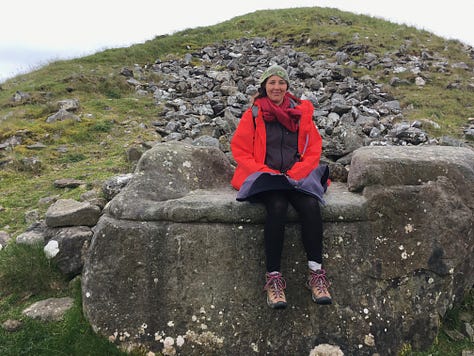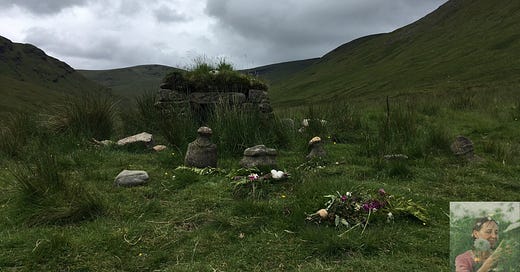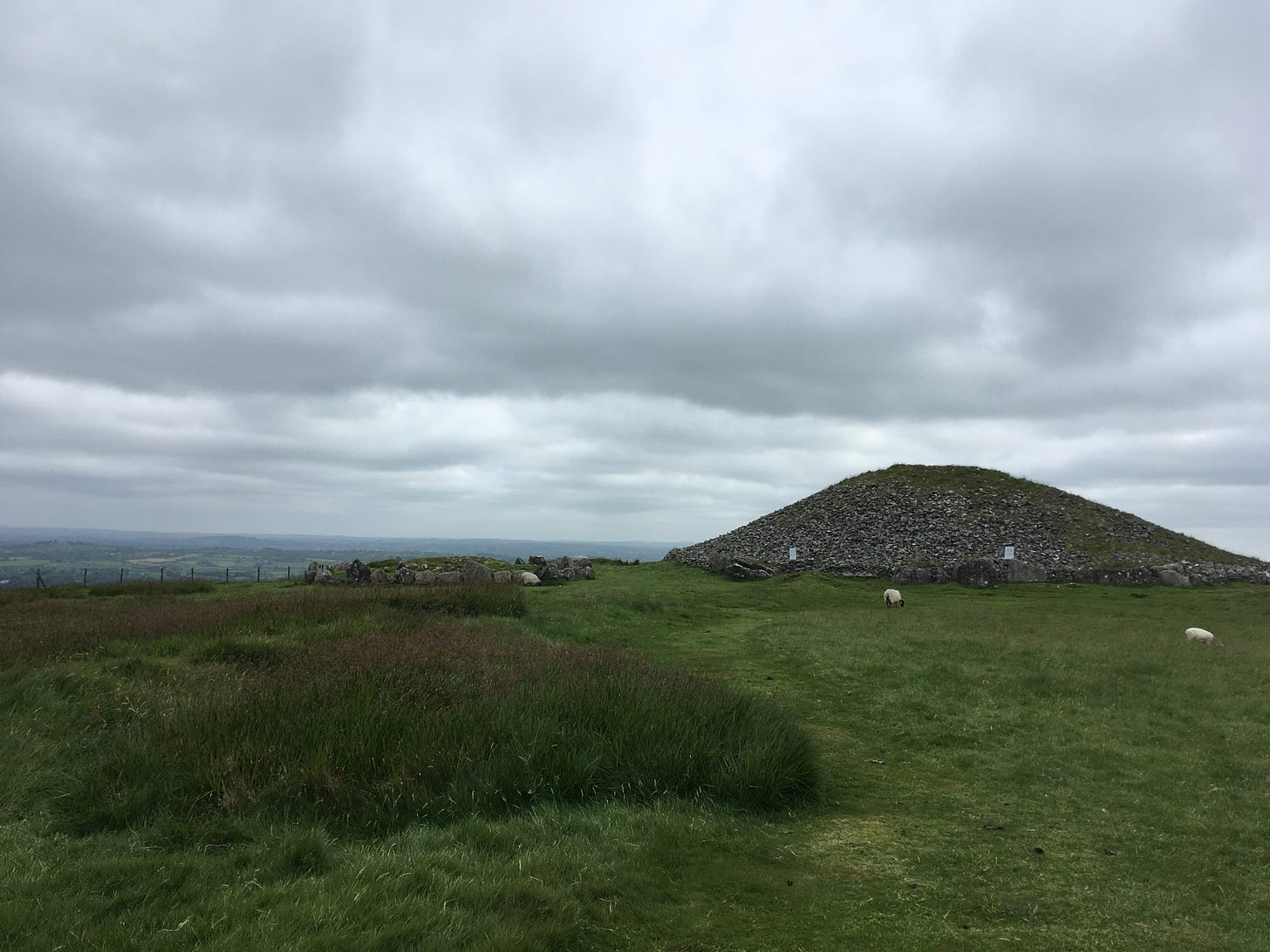Cailleach, the ancient hag, crone or winter goddess, has several sites dedicated to her in Ireland and Scotland. It was in visiting several of these sites – often discovering another one in the process – that the phrase chasing the hag came to mind.
Yet at some point along the way, it dawned on me that it wasn’t me chasing the hag, but actually the other way around. I was quite literally being chased by the hag.
That the outer world is a reflection of our inner world is foundational wisdom to me (from personal experiences with alchemy and plant spirit, as well as a long-time dabbler in Jungian thought).
Why was I being drawn to pilgrimage to these sacred Crone sites, places of the Cailleach, the hag? The answer was there all along - as within, so without. I am walking the edges of hagdom within myself – perimenopause.
For the next three weeks, I am going to share a three part series inspired by the Hag.
1. Chasing the Hag across Ireland.
2. Dancing in the dark – Navigating the gifts of perimenopause.
3. Being chased by the Hag – The Crone’s Initiation.
Part 1. Chasing the Hag
Cailleach’s sacred sites in Ireland
While Bride or the later version St. Brigid, is visible everywhere across Ireland with holy wells by the dozen named after her, Cailleach (which literally means ‘hag’ or ‘old woman’) is slightly less visible. But she is there nonetheless.
It feels important to note that Bride and Cailleach have deeper associations with one another especially in Scotland and that they are very possibly two aspects of the same being as they carry many overlaps.
Cailleach is very much a creator being, a great mother figure who was known to have created the landscape itself. And without going into all of the complexities of these two, Bride could be seen as a more youthful aspect of Cailleach, being generally depicted as maiden, despite her triple aspect. Looking at Bride from this point of view, she is more of a maiden mother figure, not yet capable of such cosmos and landscape creation as Cailleach, yet she does oversee many aspects of nature as she blossoms and grows into her fullness. In very oversimplified terms, Bride could be looked upon as a younger aspect of maiden and mother, while Cailleach is the crone – a great mother figure – who is mother to all, a cosmic mother. For more on this, you can read the plant spirit teachings of Mugwort, which is also sometimes known as Cronewort.
It is Bride who is born at Imbolc, springing forth into the light at dawn (and all the associations that brings with it – wellsprings, lightbringer, Spring itself, plants coming back to life after winter etc.). While Cailleach is the Winter crone, who comes into her strength and power at Samhain. In one later legend, at the end of Cailleach’s reign (Winter) she goes to the well on the Isle of Eternal Youth (article on this well is coming up next month in the wellspring series for paid subscribers) to drink from the waters. This transmutes her into youth and beauty again – her Bride or maiden aspect, though by Samhain, the crone returns, ready to rule the inner half of the year, to bring the winds and the snow.
There is so much beautiful depth and a fascinating broad scope to Cailleach, I cannot even attempt to cover her in here. (I’ve included some great article links to learn more if you wish, and I cover her a little more in my upcoming serialisation on substack – also starting next month).
Cailleach in Ireland
There are three peninsulas in the southwest of Ireland, each named for one of the three Cailleachs.* They jut out like three fingers, separated by the ocean. Cailleach was the ancient chief goddess of the people of the area - the Corca Duibne.
The northernmost of the three is Dingle peninsula presided over by Cailleach Duingin. In the middle is the Iveragh peninsula (Ring of Kerry) watched over by Cailleach Bholais; and the southernmost is named for the Cailleach herself – the Beara peninsula for Cailleach Beara/Bheara. It is here that we begin as it is Cailleach Beara who is named all across Ireland.
The Hag of Beara
A friend in west Cork drove us around the Bheara peninsula on a bitterly cold Spring day. It was only by lunchtime that we began to thaw out, though the stone circles we were visiting were set in the most stunning locations amidst mountains and water. It was at one of these stone circles – Ardgroom that I met a hag or a crone stone.
Sitting with my back to one of the standing stones and gazing at those opposite me, I begin to feel a story, frozen in time within them. Record-keeping or storytelling stones! Each stone has a rather unique personality. One of them is a King stone, who is facing a woman – a princess of some sort who seems somewhat anxious and concerned as she looks back at the King. Behind the princess, stands the hag (stone) who has blotches all over her face and is spewing something out of her mouth as she looks at the King. She is wiser and older, and definitely a little ugly.
Is it the legend of the Hag testing the King in order that he marry the princess?
Or is it something more complex, like the legend of the love of Etain and Midir and the witch (a similar role to hag), Fuamnach who is already married to Midir and so condemns Etain to many years being blown about as a butterfly. That would explain the curse falling out of the crone’s mouth, and the anxiety of the princess.
My mind wanders and wonders and as it does I drift asleep. As do both of my companions, also both resting upon stones. We later discover it had been at the exact peak of the full moon time that we had tranced into a nap. When we arise and make to leave, my partner is buzzing and singing a song “I dance with the wizards, I sing with the crones, I laugh with the pixies, and I dig with the gnomes.” It seems the crone had danced into his awareness also.
Our next stop is An Chailleach Bhéarra – the Bheara Hag stone near Kilcatherine that sits overlooking Coulagh Bay. It is said that the stone is the Hag of Beara herself, ancient as the days, looking out to sea waiting for her husband, Manannan mac Lir, the sea god, to return to her.
Here the sign tells us Cailleach lived for seven periods of youth, so that every man she was with, she outlived, and that she had so many grandchildren, whole tribes on both Ireland and Scotland were/are her descendants. It goes on to tell the Christianised version of her tale.
Cailleach lived here for so long, that she lived into Christian times when a St. Caithighearn (Naomh Caitiarin) arrived in the area (Kilcatherine). Cailleach being wise beyond words, wasn’t into the Christian ways (“a threat to her powers” says the sign board), and one day she came across the saint sleeping and took off with his prayer book. But a cripple saw her and yelling, woke the saint, who realising what had happened chased after the hag, catching her at Ard na Caillí (high/hill of Cailleach). Retrieving his prayer book he turned her into a stone where she remains to this day looking out to sea.
The rock is still revered, with offerings upon and around it.
The Lament of the Hag of Beara (a version of it can be found here), is an old Irish poem from the 10th century, in which Cailleach laments her lost youth, remembering her past and sitting in the ebb of life.
This feels a beautiful place to start to embrace the Hag within. To pay respects to the Hag and look to an integral stage of the journey into hagdom - the need to lament and release the past so that we can be completely present in the now. What’s gone has gone. It is a quest for all that watch the years turning by – the seasons changing, the youth evolving in new directions, to witness the ebbtide within where once there was a flood of vitality. To grieve and lament the past, so that we can be fully attendant to the present and a new role of the wise elder crone.
Cailleach Beara’s House.
The megalithic cemetery of Carrowmore in County Sligo, is said to have been built by a Cailleach (hag) known as Garavogue. Her home is atop the nearby mountain of Slieve Daeane – in a neolithic tomb, which to this day is known as the Hag of Beara’s House. Roberts* tells us the Garavogue river is named for the local water goddess who is the crone aspect of warrior Queen Mebdhe/Maeve. Essentially, Queen Mebdhe in her cailleach phase. The overlaps are endless. Maeve’s mother was Croghan, who sounds like another version of Cailleach – she too, is an ancient earth goddess, but her story is for another article.
Slieve Gullion in County Armagh has the highest passage tomb in the country. It too, is known as Cailliach Birra’s House. Oriented to the winter solstice sunset for the winter goddess. Nearby is the Lake of Sorrows or Calliagh Birra's Lough. It is said that anyone diving into its waters will become immediately elderly. In legend, it is here that Cailleach tricked Fionn into diving into its waters, and though she was forced to give him a potion to reverse the aging effect, Fionn’s hair remained white, giving him his name (Fionn = white). A little down the mountain somewhere is a rock known as Cailleach Birra’s chair. While I didn’t get the chance to visit this chair, I did visit her chair in County Meath at the Mountains of the Hag…
The Hag Mountains
Cailleach as a great mother/earth goddess figure mythically created many of the ancient cairns of Ireland purportedly by dropping stones from her apron. The Mountains of the Hag/Witch - Sliabh or Slieve na Caillí at Loughcrew were created in this way. These mountains consist of three or four mountains, across which Cailleach hopped and deposited the stones from her white apron to create the cairns.
In this poem, she is named Garavogue.
"Determined now her tomb to build,
Her ample skirt with stones she filled,
And dropped a heap on Carnmore;
Then stepped one thousand yards, to Loar,
And dropped another goodly heap;
And then with one prodigious leap
Gained Carnbeg; and on its height
Displayed the wonders of her might.
And when approached death's awful doom,
Her chair was placed within the womb
Of hills whose tops with heather bloom"
Jonathan Swift, c. 1720
The Loughcrew complex contains over 30 ancient passage tombs that are much older than Newgrange, dated to around 3500-3300BCE. It’s known that the earliest origins of the people came originally from Turkey (Anatolian DNA). It is said that Cailleach died on a nearby mountain, the place marked by a stone.
There is some amazing megalithic art at Loughcrew, and atop one of the Hag hills sits the Hag’s Chair which has a fantastic view of the surrounding area.






It is here upon the Hag’s Chair, embracing my inner hag in the chilly wind, that it dawns on me that I am the hunted not the hunter. It is the hag who is chasing me. That I am drawn to her sites as I am being called to embrace and explore my inner hag. To begin to welcome her into my world.
Stay tuned next week for Part 2: Dancing in the Dark – a more personal journey on navigating the ‘gifts’ of perimenopause; and Part 3: Being Chased by the Hag – The Crone’s Initiation.
About Heidi
I’ve been walking the plant spirit path for close to 30 years. With herbalism, homeopathy, and plant alchemy/spagyrics as early companions, midwifery and shamanism came a little later. After years of listening to the plants, I’ve since taught hundreds of people how to deepen their connection with nature and learn to hear the whispers of plants. I continue to offer The Flower Codes Training/ Shamanic Herbalism online course, as well as various in person shamanic nature-based courses such as Herbal Alchemy.
My published books include:
"The Flower Codes: Plant Spirit Teachings for your Soul to Blossom."
"Wild Flower Walker: A Pilgrimage to Nature on the Bibbulmun Track”;
and Blue Triangle Butterfly: A Homeopathic Proving.
Reference
*Roberts, Jack, The Sacred Mythologial Centres of Ireland. 2016. Bandia Publishing.
Recommended reading on the Cailleach:
Scott, Richardson-Read, The Cailleach – A Tale of Balance Between Darkness and Light (part one & two)












What a wonderful and evocative journey... If I ever can get to Ireland it would be wonderful to take my own journey to/with the Crone!
I could definitely feel that too Heidi. The hag chasing me down, thanks for putting that into words !!! A very humbling experience.